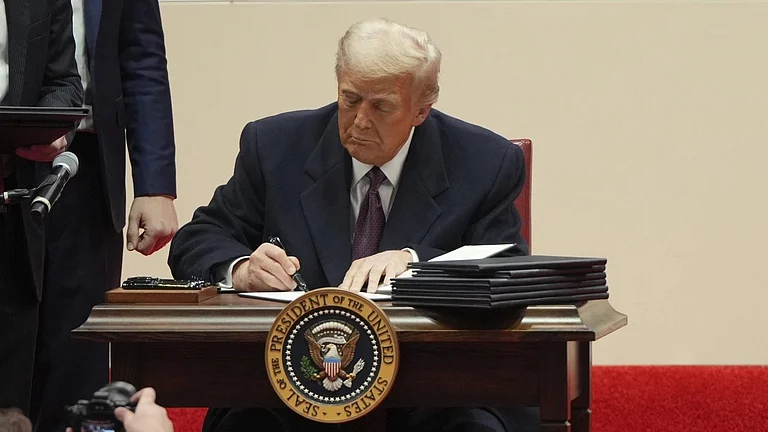CALL it what you want--pure inefficient planning, a deliberate scheme, or a dark scam--but the bottomline is the same: for short-term private power projects, the Indian exchequer will have to shell out an extra Rs 92,831 crore over the next 15 years. Or Rs 6,189 crore every year. In foreign exchange. Outlook investigates:
Eighteen months after the govemment announced the liquid fuel policy for short-gestation power plants, the directive, mired in confusion, is sitting at the edge of controversy. The multi-crore question: should naphtha be used as a fuel to generate electricity? Even in the short-term? In September 1996, petroleum and natural gas secretary Vijay L. Kelkar was quoted by a national daily as saying that naphtha use should be discouraged as it was expensive and risky. Around the same time, at a seminar organised by FICCI and the industry ministry, power secretary P. Abraham advised power companies to wait and watch before tying up power purchase agreements (PPAS) With state electricity boards (SEBS) for naphtha-based projects. Neither of them were available for any comment on this issue, despite repeated phone calls and fares.
The seeds of the seam were planted on November 6, 1995, when the ministry of power recognised that large thermal and hydel projects would take their time coming--five years and more. In order to "avert a severe power crisis", said a resolution, quick-capacity addition would have to be ensured. As a result, the government allowed private power companies to set up smaller capacity plants using liquefied fuels like heavy petroleum stock, low sulphur heavy stock, furnace oil and natural gas, depending on availability. On the same day, in a separate notification, the same ministry included naphtha among the fuels to be used by these power plants.
Outlook studied all the projects commended for provisional fuel linkage to the power ministry. The result: of the total 10,266 MW project capacity in 10 states- Andhra Pradesh, Gujarat, Haryana, Karnataka, Kerala, Madhya Pradesh, Maharashtra, Rajasthan, Tamil Nadu and Uttar Pradesh-naphtha accounted for 7,998 MW. Or almost four-fifths of all projected capacity.
That's rather strange. On two counts. One, given that naphtha is a much more expensive fuel than say furnace oil, how come nearly 80 per cent of all independent power producers (IPPS) have gone in for the costly route? And two, why has the government allowed it? In a letter addressed to state governments, dated October 7, 1996, P.K. Basu, director (IPC) in the ministry of power, wrote: "Large capacities based on fuels which have to be imported can't be sustained in the long run, and power generation on (sic) liquid fuels, especially naphtha, was not a preferred source.... State governments are requested to exercise utmost restraint." Consider the comparative costs of setting up and running a 100 MW power plant using naphtha and furnace oil. In you put up a combined cycle gas turbine (CCGT, a plant powered by gas or naphtha), it would cost Rs 300 crore. The alternative-diesel generator (DG) plant, which runs on furnace oil-costs 17 per cent higher at Rs 350 crore.
Now, take a look at the fuels. The cost of naphtha is Rs 10,430 per tonne-76 per cent greater than furnace oil (Rs 5,925 per tonne). A 100 MW cccT will need 125,000 tonnes of naphtha to fuel it, while a 100 MW DG plant will need 133,000 tonnes of furnace oil. The respective annual costs: Rs 130 crore and Rs 79 crore. So the DG set will save about Rs 51 crore right in the first year of operation. And every year after that.
It was therefore not surprising that in none of the 32 similar capacity greenfield private plants in emerging markets from China to Honduras, and Jamaica to Pakistan, was naphtha being used as fuel. So why are Indian power companies opting for naphtha? For one, the fact that naphtha is more expensive makes no difference to their profit margins. That's because the nature of tariff in most states is of a "passthrough" nature. That is, all expenditure incurred on fuel will be reimbursed to the IPPS by the SEBS, which in turn will push the burden onto the consumer This, therefore, insulates the IPP from any kind of fluctuations in fuel prices.
The two exceptions: Haryana and Tamil Nadu. Haryana scrupulously invited bidsand took a decision based on the lowest tariff offered on a fuel price of Rs 5,000 per tonne. It fixed the first-year tariff at Rs 2.40 per kilo watt hour (kWh). Among the powerb projects of the 10 states we studied, these two were the only ones where the capacity of furnace oil-based plants was more than that of naphtha-based ones (in Tamil Nadu, of the 320 MW of total capacity, 200 MW is from furnace oil-based plants). This leads to a singular conclusion: wherever the states considered the true economics of the projects, the IPPS did not prefer naphtha.
At the end of the day, however it's not macroeconomic factors but what you, the consumer, will pay for electricity that matters. To this end, the first year tariff in case of naphtha-based plants is Rs 2.92 per kWh--17 per cent higher than that for furnace oil-based electricity the tariff for which would be Rs 2.49 per kWh. This, really, is not what you will be paying, but the price that the SEBS Will be paying to the IPPS. The price you'll pay, of course, depends on whether you're an industrial consumer or a household or an agricultural unit and the tariff the SEB fixes for your segment.
BUT all these numbers are based on assumptions that are not constant: the forex fluctuations do not adversely affect the Indian rupee, the prices of raw materials don't change and the plants operate at a plant load factor (PLF) Of 80 per cent. And none of them will work positively.
Forex Fluctuations: Once the rupee becomes fully convertible, the probability of it depreciating is higher than it appreciating. Thus, for instance, if the IPP is paying $100 (Rs 3,600) for fuel today, a 25 per cent depreciation in the value of the rupee will cost the producer Rs 4,500. In order to meet its costs, the IPP Will either increase tariff in the same proportion, or close down.
Raw Material Pendulations: If you study the trends in prices of the two raw materials-- naphtha and furnace oil--there's a clear course: the fluctuations in case of naphtha are more pronounced. What this means is users of naphtha will be more vulnerable to price changes. Under these circumstances, there's less chance to predetermine costs
.High PLF: Against the country's average PLF of around 65 per cent, the tariff calculations for the liquid fuel policy has assumed a PLF of 80 per cent. In all likelihood, this may not be achieved--by either of the plants. Thus, all calculations for return on investment could go haywire.
Availability: The surplus naphtha available from the Gulf region is 12 million tonnes. Of this, a whopping 80 per cent has been tied up in various contracts for Japan. Which leaves 2.4 million tonnes free. If all naphtha-based projects do finally come up, the amount of naphtha these plants will require adds up to 15 million tonnes. This is not considering the use by fertiliser companies, which is also on the rise. Singapore is the other option, but the economics of importing from there do not make sense. The upshot: the country becomes extremely vulnerable to rising prices, in a commodity of national importance. If you were to balance the dem-and-supply equation, the price of naphtha could well touch $400 per tonne (it's currently around half of that).
All these assume monstrous proportions if you consider this last bit of number-crunching. The current oil pool deficit stands at Rs 15,500 crore. The prime minister has already hinted at an inevitable oil price rise. It could be up to 30 pet cent. On the other hand, a switch from naphtha to furnace oil-based power plants for the slated 12,000 MW capacity will reduce the annual burden on the Indian exchequer by Rs 6,189 crore every year. In foreign exchange.


























